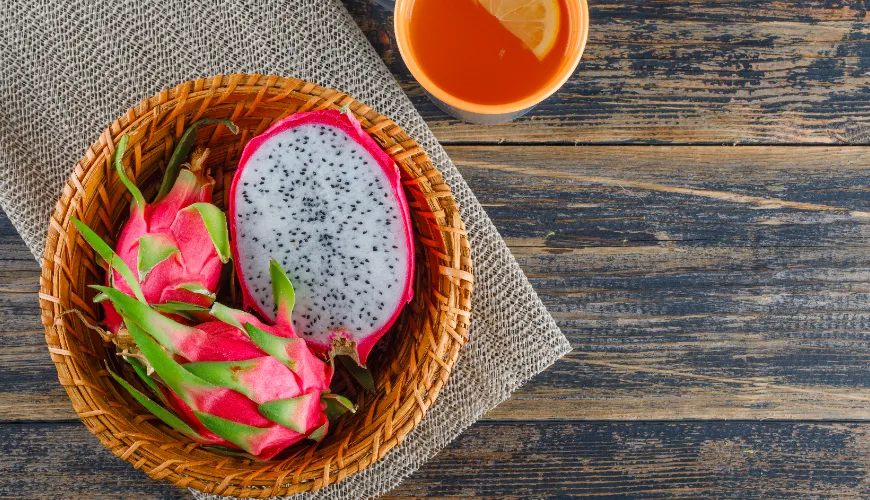
How to eat dragon fruit and why to include it in your diet

Dragon fruit, also known as pitaya, pitahaya, or pitája, is an exotic fruit that is gaining increasing popularity due to its unique appearance and numerous health benefits. This fruit enchants not only with its looks but also surprises with its taste and nutritional values. Let’s take a look at the nutritional values of dragon fruit and find out how to eat dragon fruit and what it can offer us.
What is dragon fruit?
Dragon fruit comes from the cactus genus Hylocereus, which is primarily found in Central and South America. There are three main types of dragon fruit: red with white flesh, red with red flesh, and yellow with white flesh. All of these fruits share a characteristic scaly skin that resembles dragon scales.
Each type of dragon fruit has its specific taste properties and appearance. The red with white flesh is the most common, and its taste is often described as mildly sweet with a refreshing touch. The red with red flesh is sweeter and has a more intense color, making it a popular ingredient for various culinary creations. The yellow with white flesh is the least common, but its sweetness and aroma are highly regarded.
Nutritional values and health benefits
Dragon fruit is rich in vitamins, minerals, and antioxidants that support overall health. It contains vitamin C, B1, B2, B3, as well as minerals such as iron, calcium, and phosphorus. The antioxidants found in dragon fruit help protect the body from free radicals, thus reducing the risk of chronic diseases.
Supporting digestion is one of the main benefits of consuming dragon fruit. Its high fiber content aids healthy digestion and prevents constipation. It also boosts the immune system due to its high vitamin C content, which helps the body fight infections. Dragon fruit promotes heart health thanks to its content of omega-3 and omega-9 fatty acids, which lower cholesterol levels. The high water content in dragon fruit helps keep the body hydrated, which is especially important during hot summer months.
Another significant advantage of dragon fruit is its low calorie content, making it an ideal part of a diet. The combination of low calorie value and high fiber content also contributes to a feeling of fullness, which can aid in weight loss.
Try our natural products
How to eat dragon fruit?
One of the most common questions people often ask is how to eat dragon fruit. And the answer is surprisingly simple. First, wash the fruit thoroughly to remove any dirt from its surface. Then, cut the fruit in half lengthwise. The flesh inside the fruit is soft and juicy, so you can easily scoop it out with a spoon directly from the skin or gradually peel the skin away with a knife and cut the flesh into pieces.
You can cut the flesh into cubes and add it to fruit salads, smoothies, or use it as a topping on cakes and other desserts. Dragon fruit can also be frozen to create a refreshing sorbet or added to ice cream.
Speaking of creative ways to enjoy this fruit, consider blending dragon fruit with banana and coconut milk for a delicious smoothie bowl. This mixture can be topped with fresh fruits, granola, and seeds. If you prefer something refreshing, try combining cubes of dragon fruit with pineapple, mango, and kiwi, which can be complemented with a bit of lime juice and mint.
If you enjoy jams, dragon fruit can also be cooked with sugar and lemon juice until it reaches a jam-like consistency. This jam is great on bread or as an addition to yogurt. A refreshing drink made from dragon fruit can be prepared by blending dragon fruit with water, lemon juice, and a bit of honey. This drink is perfect for hot summer days.
How dragon fruit is eaten in different cultures
Dragon fruit is popular not only in its countries of origin, namely Mexico, Central America, and the Caribbean, but also in Asia, where it is often part of traditional dishes. In Thailand, dragon fruit is often served as part of breakfast alongside other exotic fruits. In China, dragon fruit is considered a symbol of prosperity and is often served during festive celebrations.
In Mexico, where dragon fruit originates, it is often consumed fresh and simply cut into cubes. In these cultures, dragon fruit is frequently regarded as a delicacy and is part of many festive meals. Although it is valued primarily for its appearance and taste, its health benefits are equally important and appreciated worldwide.
Dragon fruit has also found its way into modern gastronomy, where it is used to create innovative dishes and drinks. For example, in Japan, it is added to sushi, where its sweetness and delicate texture contrast beautifully with other ingredients. In Australia, it is popular as an ingredient in exotic cocktails and juices.





